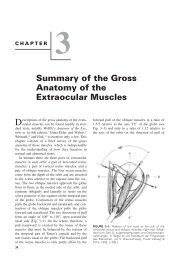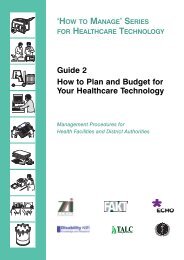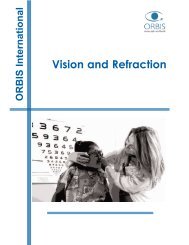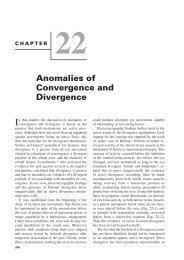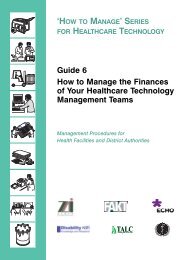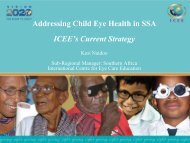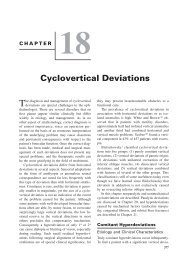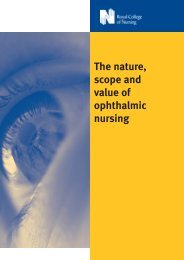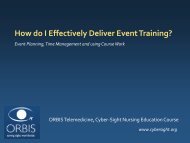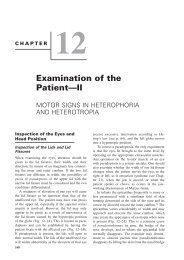Chapter 17: Exodeviations
Chapter 17: Exodeviations
Chapter 17: Exodeviations
Create successful ePaper yourself
Turn your PDF publications into a flip-book with our unique Google optimized e-Paper software.
368 Clinical Characteristics of Neuromuscular Anomalies of the Eyeavoid overcorrection. In the interval, he reinforcesfusion with minus lenses or prevents developmentof suppression by means of alternating occlusion.On the other hand, Knapp 98 is an advocate of earlysurgery for treatment of intermittent exotropia, aview shared by other authors. 3, 50, 146, 151, 156 Morerecently, however, Baker and coworkers 8 found ina comparative study that patients operated on afterthe age of 4 years had better functional results.We prefer to delay surgical intervention forintermittent exotropia in young children, since weshare Jampolsky’s concern about the effects of aconsecutive esotropia in a visually immature child.Unfortunately, in such patients, good preoperativevisual acuity in each eye with normal stereoacuitymay have been exchanged for persistent monocularesotropia with amblyopia, loss of stereopsis,and the development of anomalous retinal correspondence.Edelman and coworkers 52 reported that5 of 24 children who developed consecutive esotropiaafter surgery for exotropia before the ageof 4 years became amblyopic. Even when surgerywas delayed until the age of 4 to 6 years, amblyopiastill occurred in 3 of 39 patients.Although the prevalence of consecutive constantesotropia in patients under 5 years of agehas been reported to be only 10%, 96, 120, 151 we havewitnessed this unfortunate event in a sufficientnumber of our patients to advocate delaying surgeryuntil the child has reached at least 4 years ofage. In the interim, binocular vision should bereinforced with prisms base-in or minus lenses.Surgery at an earlier age should be consideredonly if there is a rapid functional deterioration offusional control in spite of nonsurgical therapy orif the deviation is constant.Finally, the size of the deviation determinesthe decision to operate. The angle of primaryexodeviations generally exceeds 20 , and unlikethe situation in esotropia, small angle exodeviationsare rare. If for functional reasons surgery isindicated, the deviation should measure at least15 at distance or near fixation before a procedureis carried out. Patients are seldom self-consciousor embarrassed by strabismus of this magnitudeand surgery usually is not performed unless thedeviation measures at least 20 to 25 .GOALS OF SURGERY. Although the aim of mostoperations for strabismus is to align the eyes asnearly as possible, many ophthalmologists haveproposed that for intermittent exodeviations asmall surgical overcorrection is desirable, since itappears that functional results will be more stable.Raab and12; 41; 53; 64; 81, p. 645; 90; 98; 152; 154; 164; 185Parks 152 proposed that the surgeon should strivefor an overcorrection of 10 to 20 . Lesser degreesof overcorrection have been associated with recurrenceof the exodeviations after some time haselapsed. A higher degree of overcorrection willnecessitate further surgery for consecutive esotropia.Proponents of deliberate overcorrection citethe therapeutic value of postoperative diplopia instimulating development of fusional vergences andthus in stabilizing eventual alignment of the eyes.On the other hand, it has also been shown that aninitial overcorrection does not guarantee a desirablefinal outcome. 159 Dunlap 51 observed that thedifficult element in striving for overcorrection isknowing how to produce some, but not too muchof it. In one series of his patients the prevalenceof unintended overcorrection was 40%, whereasCooper, 41 who deliberately attempted to overcorrecthis patients, reported a prevalence of only37%. Since introduction of adjustable sutures thisunpredictability has become less of a problem.We are in agreement with those who believethat a small angle of consecutive esotropia in theimmediate postoperative phase is desirable andtends to stabilize a functional result, even thoughsuch deviations occasionally may persist for along time and cause problems of management (seeCase <strong>17</strong>–4). However, we have been unable toaccomplish this goal other than by pure chance orby postoperative suture adjustment.As pointed out above, surgical overcorrection,as beneficial as it may be in the older child oradult, must be avoided under all circumstances invisually immature children in view of the disastrousconsequences of a small angle esotropia inthis age group. On the other hand, Schlossmanand coworkers 162 concluded from their data thatadult patients do better with slight undercorrectionrather than overcorrection after surgery, providedthe residual exodeviation remains under 15 .Although it may be difficult or even impossibleto plan surgery to achieve a small, beneficialamount of overcorrection, there may be ways toavoid overcorrection in cases in which it is undesirable.The importance of including lateral gazeincomitance into the surgical planning has beenmentioned.CHOICE OF PROCEDURE. Burian 26, 31 emphasizedthat correct differentiation between the true andsimulated divergence excess patterns is essential



